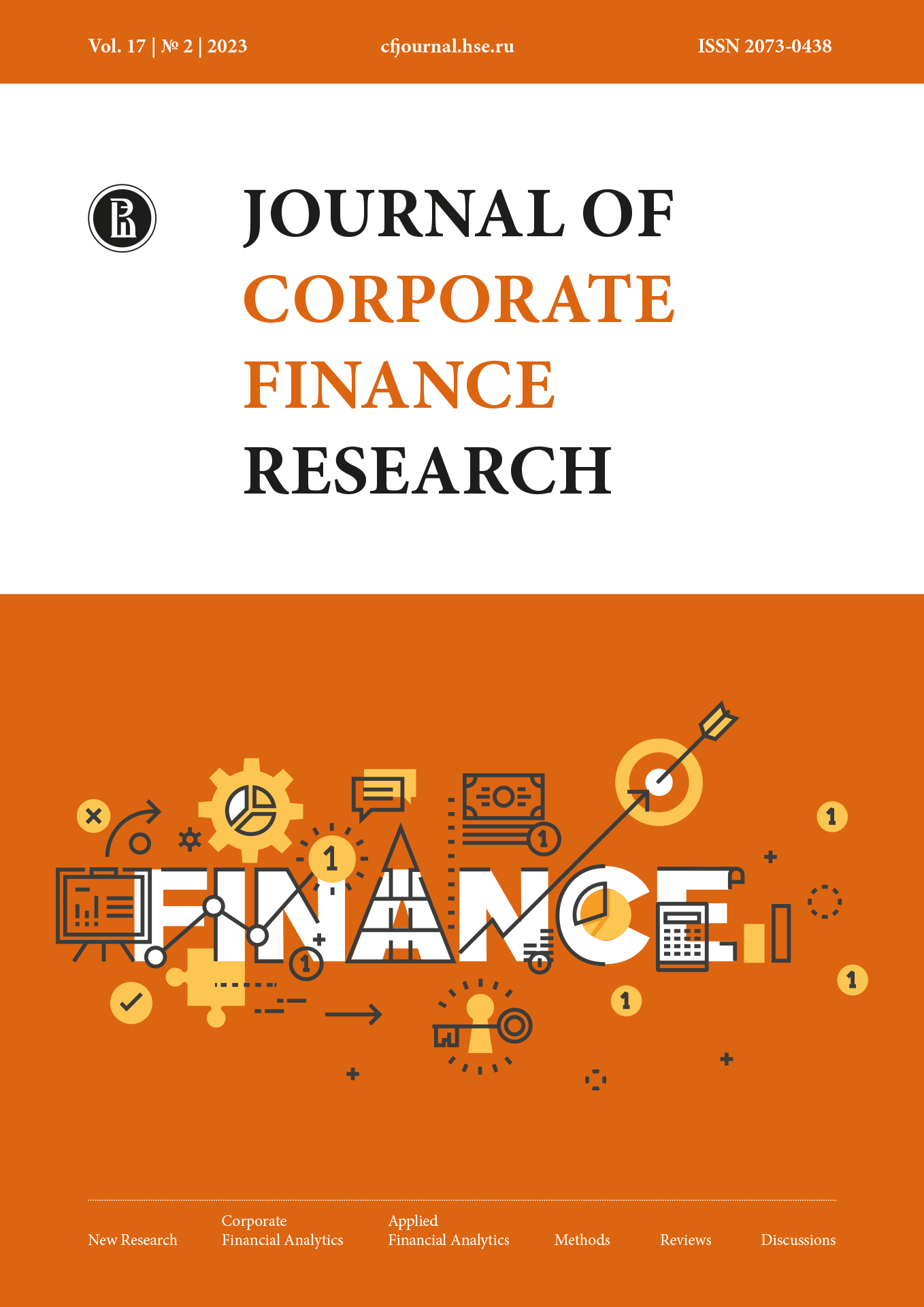Impact of Board of Directors on Funds Raising: Evidence for Green Bonds
Abstract
The present paper attempts to reveal influence of characteristic features of the board of directors (BD) on fund raising using green bonds. The research involved a sample of 87 public companies which issued green bonds in 2021. We analyzed influence of such factors as the proportion of women and independent directors on the BD, CEO duality and the number of the BD members by the share of green bonds in the total debt of the company. The share of debt in the assets, the natural logarithm of total assets (company size) and return on equity (ROE) were used as control variables.
The logarithmic specification of the classical linear regression model was chosen as the optimal one. So, heteroscedasticity, autocorrelation and multicollinearity were not detected in the model with the dependent variable logarithm (the share of green bonds in the total debt). The least squares method (LSM) was applied to evaluate this model. As long as the initial sample of companies which issued green bonds in 2021 comprises both financial and non-financial companies we verified the validity of the obtained results for two types of companies. Assessment of the optimal model for two subsamples of financial and non-financial companies yielded results somewhat different from the ones obtained from analysis of the total sample. Evaluation of the regression for financial and non-financial companies showed a reduction in significance of influence exerted by women’s representation and the size of the BD. However, in case of non-financial companies the significance of such factor as presence of the sustainable development committee increases. According to the obtained results the companies with the CSR committee attract relatively larger financing using green bonds.
Downloads
References
Segal T. Green bond: Types, how to buy, and FAQs. Investopedia. URL: https://www.investopedia.com/terms/g/green-bond.asp (accessed on 17.04.2022).
Sustainable debt market Summary Q3 2021. Climate Bonds Initiative. 2021. URL: https://www.climatebonds.net/files/reports/cbi_susdebtsum_q32021_03b.pdf (accessed on 17.04.2022).
Naciti V. Corporate governance and board of directors: The effect of a board composition on firm sustainability performance. Journal of Cleaner Production. 2019;237:117727. https://doi.org/10.1016/j.jclepro.2019.117727 DOI: https://doi.org/10.1016/j.jclepro.2019.117727
Valls Martínez M.d.C., Martín-Cervantes P.A., Miralles-Quirós M.d.M. Sustainable development and the limits of gender policies on corporate boards in Europe. A comparative analysis between developed and emerging markets. European Research on Management and Business Economics. 2022;28(1):100168. https://doi.org/10.1016/j.iedeen.2021.100168 DOI: https://doi.org/10.1016/j.iedeen.2021.100168
Karim S. Do women on corporate boardrooms influence remuneration patterns and socially responsible practices? Malaysian evidence. Equality, Diversity and Inclusion. 2021;40(5):559-576. https://doi.org/10.1108/EDI-07-2020-0213 DOI: https://doi.org/10.1108/EDI-07-2020-0213
Endrikat J. et al. Board characteristics and corporate social responsibility: A meta-analytic investigation. Business & Society. 2021;60(8):2099-2135. https://doi.org/10.1177/0007650320930 DOI: https://doi.org/10.1177/0007650320930638
Prudêncio Р. et al. Effect of diversity in the board of directors and top management team on corporate social responsibility. Brazilian Business Review. 2021;18(2):118-139. https://doi.org/10.15728/bbr.2021.18.2.1 DOI: https://doi.org/10.15728/bbr.2021.18.2.1
Chen S., Hermes N., Hooghiemstra R. Corporate social responsibility and NGO directors on boards. Journal of Business Ethics. 2022;175(3):625-649. https://doi.org/10.1007/s10551-020-04649-4 DOI: https://doi.org/10.1007/s10551-020-04649-4
Francoeur C. et al. To what extent do gender diverse boards enhance corporate social performance? Journal of Business Ethics. 2019;155(3):343-357. https://doi.org/10.1007/s10551-017-3529-z DOI: https://doi.org/10.1007/s10551-017-3529-z
Beji R. et al. Board diversity and corporate social responsibility: Empirical evidence from France. Journal of Business Ethics. 2021;173(1):133-155. https://doi.org/10.1007/s10551-020-04522-4 DOI: https://doi.org/10.1007/s10551-020-04522-4
Uyar А. et al. Board structure, financial performance, corporate social responsibility performance, CSR committee, and CEO duality: Disentangling the connection in healthcare. Corporate Social Responsibility and Environmental Management. 2021;28(6):1730-1748. https://doi.org/10.1002/csr.2141 DOI: https://doi.org/10.1002/csr.2141
Jin R., Jiang X., Hu H.W. Internal and external CSR in China: How do women independent directors matter? Asia Pacific Journal of Management. 2023;40(1):169-204. https://doi.org/10.1007/s10490-021-09783-9 DOI: https://doi.org/10.1007/s10490-021-09783-9
Birindelli G. et al. Composition and activity of the board of directors: impact on ESG performance in the banking system. Sustainability. 2018;10(12):4699. https://doi.org/10.3390/su10124699 DOI: https://doi.org/10.3390/su10124699
Jiang X., Akbar A. Does increased representation of female executives improve corporate environmental investment? Evidence from China. Sustainability. 2018;10(12):4750. https://doi.org/10.3390/su10124750 DOI: https://doi.org/10.3390/su10124750
Bhutta U.S. et al. Green bonds for sustainable development: Review of literature on development and impact of green bonds. Technological Forecasting & Social Change. 2022;175:121378. https://doi.org/10.1016/j.techfore.2021.121378 DOI: https://doi.org/10.1016/j.techfore.2021.121378
Zhang R., Li Y., Liu Y. Green bond issuance and corporate cost of capital. Pacific-Basin Finance Journal. 2021;69:101626. https://doi.org/10.1016/j.pacfin.2021.101626 DOI: https://doi.org/10.1016/j.pacfin.2021.101626
Taghizadeh-Hesary F. et al. Green finance and the economic feasibility of hydrogen projects. International Journal of Hydrogen Energy. 2022;47(58):24511-24522. https://doi.org/10.1016/j.ijhydene.2022.01.111 DOI: https://doi.org/10.1016/j.ijhydene.2022.01.111
Gianfrate G., Peri M. The green advantage: Exploring the convenience of issuing green bonds. Journal of Cleaner Production. 2019;219:127-135. https://doi.org/10.1016/j.jclepro.2019.02.022 DOI: https://doi.org/10.1016/j.jclepro.2019.02.022
Li Z. et al. The interest costs of green bonds: Credit ratings, corporate social responsibility, and certification. Emerging Markets Finance & Trade. 2020;56(12):2679-2692. https://doi.org/10.1080/1540496X.2018.1548350 DOI: https://doi.org/10.1080/1540496X.2018.1548350
Lin B., Su T. Green bond vs conventional bond: Outline the rationale behind issuance choices in China. International Review of Financial Analysis. 2022;81:102063. https://doi.org/10.1016/j.irfa.2022.102063 DOI: https://doi.org/10.1016/j.irfa.2022.102063
Copyright (c) 2023 National Research University Higher School of Economics

This work is licensed under a Creative Commons Attribution-NonCommercial-NoDerivatives 4.0 International License.

